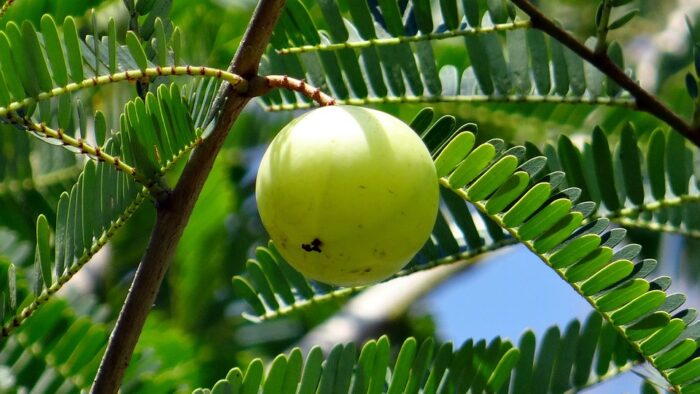In the regions where it grows, local people understand the uses of the amla fruits, branches, leaves, and tree bark. Dr. Bhaswati Bhattacharya and Dr. Ankita Ankush write about the immense value of Amlaki, and how people include it in their lives
In the places of the world where people cannot live with amalaki and watch it grow on the local tree, they use preserved forms of amla fruit, as it is commonly known. Understanding its immense value, and also its natural course of growing only in cooler temperatures, amla was thus processed into a myriad of forms.
Many Edible Forms of Amla
Amla is found in many edible forms accommodating its tight adherent pulp, such as murabba in a syrupy candied amla, dry amla candy, dried amla powder known as amchur, fresh expressed amla juice, amla cider, amla chutney made by adding fruit pulp to dhanya leaves then hing, salt and pepper; and triphala made of three fruits amalaki, haritaki, and bibhitaki. Its most popular form is chyavanpraash. Cosmetic uses include amla shampoo, hair oil, dye, tooth powder and face creams.
The annual day of paying respect to the amalaki tree is the ekadashi (11th day) of the Shukla Paksha (waxing increasing phase after the new moon) in the 12th month of Phalguna in the ancient calendar of Akhanda Bharata, which usually occurs in the Gregorian calendar of February or March. It is celebrated in Himachalpradesh and Uttarpradesh where amla grows most plentifully. Lakshmi is thought to reside in the amla tree.
There are at least ten types of amla, with variants due to various climates and soils where it grows. It prefers to grow in light and medium heavy soils of dry regions. While it is a tropical tree, it can tolerate the freezing temperatures in higher altitudes. Local people understand the uses of the fruits which can be 1.5 to 4 cm in diameter, branches, leaves, and tree bark.
The largest fruits, which are bigger than 4cm round, and which are free from blemishes and bruises are used for making aachar, chutneys, murabba candies, and a variety of preserves. Fruits with defects are cut and salvaged then dried in the sun and powdered for use in triphala. The smaller fruits are ideal for the annual batch of chyavanprash. In general, the picked fruits can be stored 2-3 weeks if kept at 10 -15 C. They are enjoyed as daily culinary side dishes through the season, switching over to the preserved dishes until the next season of amla arrives.
Varieties of Amalaki
Of the dozen varieties or cultivars of amla, there are four main ones, Banarasi, Krishna, Francis, and Chakaiya. Banarasi amla is one of the most popular varieties and like most amla plants growing in Varanasi district around the ancient city of Kashi/Benaras in Uttarpradesh state of India, it is the variety with the best medicinal qualities.
This variety ripens early compared to others, maturing fruits between mid-October and mid-November, at the time of the devi pujas. Each fruit weighs about 50grams, with smooth light-green skin and the typical 6 green striations from stem to sepal. But the fruits are more fragile and do not have a long shelf-life, and thus are not readily transported for commercial sale, but rather collected and used immediately, sometimes in culinary chutneys. but mostly they are quickly converted preserved as murabba. Freshmade Banarasi murabba can be found at local shops all over Benaras and nearby villages. The chyavanpraash made from Benarasi amla are the most therapeutic, and local residents who know clamor to the BHU (Banaras Hindu University) pharmacy outlet to get their annual supply, made accurately by the doctors of ayurveda and pharmacy staff, without any preservatives or substitutions.
Krishna amla is a commercial variety of amla due to its early ripening between late-October to late-November and into December. Its darker fruits are slightly smaller than Banarasi amla, with and average medium to large sized fruits of 45gm in weight. The skin is always smooth and the 6 stripes along the long axis are well marked. A tree will yield an average of 123 kg each season, and is commercially coded as the NA-5, Krishna amla.
Francis amla is a also mid-season crop, with fruits ripening between mid-November and mid-December. Its large fruits average 46gm in weight and are lighter, with a greenish white color. Because its branches droop significantly with the weight of its high yields, the Francis amla tree is known locally as the Hathi Jhool. These high yields make them a favourite for commercial manufacturers of amla-based products but they do not have the medicinal strength of Banarasi amla.
Chakaiya amla is a late crop, ripening between mid-December and mid-January. While the fruits are smaller compared to other varieties, with medium-sized average weight of 33gm, it contains high levels of ascorbic acid (vitamin C), which is used as a standard marker by authorities. The fruit is rich in fibre and pectin and yields a heavy crop every alternate year. Because is the most durable variety for transport and preservation, it is used for making pickles and drying shreds that are used for further product-making.
Increasingly, the non-clinical scientists, botanists and agriculturists are cleverly using economic variables to increase crops and sale of amla. They see amla for its vitamin C value and do not connect the ayurvedic nutrition value of the fruit and other parts of the tree.
Amla helps manage indigestion by improving the core digestive fire of the gut, known as pachaka pitta, the transformation of cooking. Amla also has a mild laxative property called rechana that assists movement of the gut for easier excretion of stool. At the beginning of winter, when most people have increased appetite and crave heavier foods, it is wonderful to have the belly cleaned out regularly.





